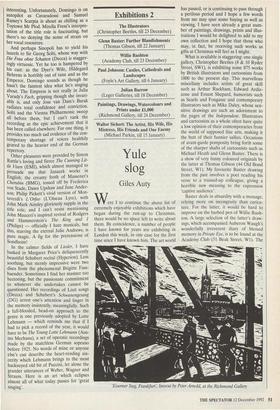Exhibitions 2
The Illustrators (Christopher Beetles, till 23 December) Glenn Baxter: Further Blandishments (Thomas Gibson, till 22 January) Willie Rushton (Academy Club, till 23 December) Paul Johnson: Castles, Cathedrals and Landscapes (Foyle's Art Gallery, till 6 January) Julian Barrow (Leger Galleries, till 18 December) Paintings, Drawings, Watercolours and Prints under £1,000 (Richmond Gallery, till 24 December) Walter Sickert: The Artist, His Wife, His Mistress, His Friends and One Enemy (Michael Parkin, till 15 January)
Yule slog
Giles Auty
Were I to continue the above list of extremely enjoyable exhibitions which have begun during the run-up to Christmas, there would be no space left to write about them. By coincidence, a number of people I have known for years are exhibiting in London this week, in one case for the first time since I have known him. The art world -..-
has passed, or is continuing to pass through a perilous period and I hope a few words from me may spur some buying as well as viewing. I have seen already a great num- ber of paintings, drawings, prints and illus- trations I would be delighted to add to my own collection and I hope that those who may, in fact, be receiving such works as gifts at Christmas will feel as I might.
What is available is staggering: one single gallery, Christopher Beetles (8 & 10 Ryder Street, SW1), is exhibiting some 875 works by British illustrators and cartoonists from 1800 to the present day. This marvellous miscellany includes artists of great skill such as Arthur Rackham, Edward Ardiz- zone and Ernest Shepard, humorists such as Searle and Fougasse and contemporary illustrators such as Mike Daley, whose sen- sitive drawings are such an adornment to the pages of the Independent. Illustrators and cartoonists as a whole often have quite a low opinion of their contemporaries from the world of supposed fine arts, making it the butt of their funnier sallies. Occasions of avant-garde pomposity bring forth some of the sharper shafts of cartoonists such as Michael Heath and Glenn Baxter. There is a show of very funny coloured originals by the latter at Thomas Gibson (44 Old Bond Street, WI). My favourite Baxter drawing from the past involves a poet reading his verse to a trussed-up colleague, giving a horrible new meaning to the expression `captive audience'.
Baxter deals in absurdity with a message, relying more on incongruity than carica- ture. For the latter, it would be hard to improve on the barbed pen of Willie Rush- ton. A large selection of the latter's draw- ings, which accompanied Auberon Waugh's wonderfully irreverent diary of blessed memory in Private Eye, is to be found at the Academy Club (51 Beak Street, WI). The `Eisemer Steg, Frankfurt, linocut by Peter Arnold, at the Richmond Gallery latter is a favourite watering-hole for reac- tionary journalists but I understand visits even by Guardian readers would be wel- come; all original drawings are for sale.
At Foyle's Art Gallery (119 Charing Cross Road, WC2), a positive grandee among reactionary journalists reveals con- siderable sensitivity when wielding week- end paintbrush rather than weekday broadsword. Paul Johnson's gleeful demoli- tion of the reputations of lions of the Left such as Brecht and Sartre in his book The Intellectuals gave me such pleasure when supine in an Italian hospital last winter that I shall consider myself always in his debt. But this is not what moves me to write of the skill of his topographical watercolours. Their colour is less certain occasionally than their drawing, but the very best of them, 'Crowcombe Church', could hold its own in exalted company.
At Leger Galleries (13 Old Bond Street, W1) another prolific topographical painter of quality, this time in oils, exhibits 130 works, the result of travels in recent months. Julian Barrow has become an artist of unusual consistency with a sure- ness of touch, tone and colour that argues good basic training, a keen eye and a will- ingness to look and learn. Clearly he works hard, without losing his own sense of plea- sure, for his paintings retain an agreeable freshness. Subjects include India and Kenya as well as portraits and houses in England. One of the finer of the latter is of Hinton House in Wiltshire.
At Richmond Gallery (8 Cork Street, W1) a selection of works under £1,000 includes notable bargains by such as the late Richard Eurich and Bernard Adams. Among younger artists, Alexander Cress- well and Celia Ward have cause to be proud, while Peter McNiven and a virtually unknown German, Peter Arnold, fly the flag for maturity. Arnold's linocuts show deep feeling and I have seen recently some of his oil paintings which are held at the same gallery. The artist has worked away to good effect in some obscure corner of Wales. His best work is life-enhancing.
Last but certainly not least is another highly imaginative exhibition created by Michael Parkin (11 Motcombe Street, SW1) of the work of Sickert and his associ- ates. Wonderful drawings by the former sit comfortably with excellent paintings by some of the latter: Sylvia Gosse's 'The Market Place, Dieppe', 1920, and Malcolm Drummond's 'The Plough', 1913, providing exceptional pleasure.
I regret to say time and shoe leather ran out before I could get to Salon des Graphiques at Curwen Gallery (4 Windmill Street, W1), of which I hear excellent reports. If you cannot find desirable gifts for others or yourself among what I have described you are probably spending too much time on a portable telephone.
Sheridan Morley is away. He will resume his theatre column next week



































































 Previous page
Previous page